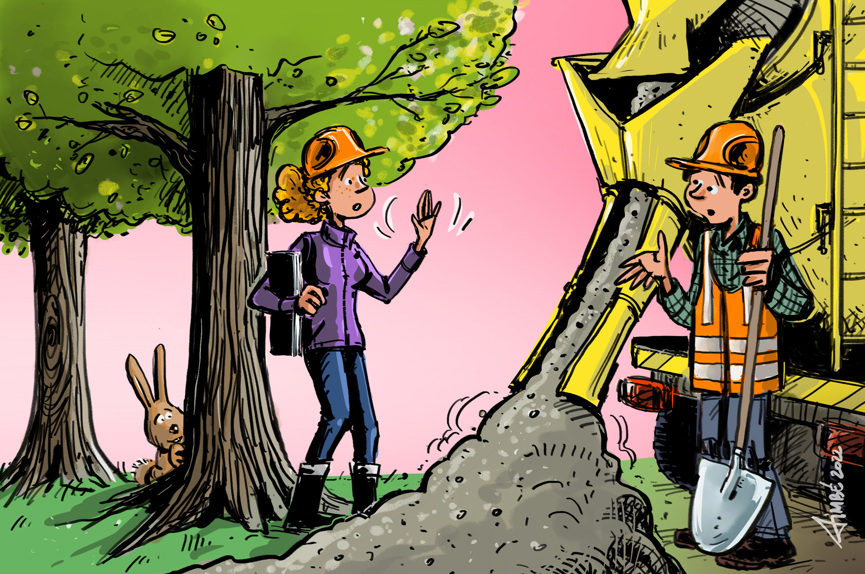- Urban planning and Environmental Law
- building shift , spatial policy planning process , planning damage , planning damage regulation , spare residential area , BRV Fund , spatial planning , owner of a building plot , building plot
The Flemish government has reached a deal on the so-called building shift, with the ultimate goal of a complete halt to the construction of buildings by 2040.
This deal will inevitably have an enormous impact on urban planning. Owners of one or more building plots will be confronted with this new situation, and should obtain information about the consequences that this governmental agreement will have for their plots, and the latter’s destination. After all, many building plots will be assigned with a different use.
In this article, we explain the main points relating to this deal.

1. What is the purpose?
The aim of this governmental agreement is that by 2025 only 3 hectares per day of additional space will be taken up for the construction of buildings, to ultimately reach a complete stop by 2040. Today, 5 hectares are being used for buildings every day.
Flanders is trying to encourage municipalities to increase, through their spatial policy planning process, the qualitative yield of space and to prevent that additional space is used for the construction of building.
2. What are the main lines of the decree?
The draft decree (called the "instruments decree"), that will implement the governmental agreement, – will include rules to compensate the so called "planning damage" based on sales value. The sales value will be determined on the basis of 13 factors.
This decree is expected to be approved in 2022.
2.1 A planning damage regulation based on the sales value
The draft instruments decree foresees rules to compensate the planning damage suffered by the owners who are affected, based on the sales value of their building plot.
"Plan damage" is the damage that owners of a plot of land suffer when their plot, as a result of the changed spatial planning, can no longer be used for the construction of building or to subdivide it with the aim of building.
With a planning damage regulation, these owners are compensated based on the value that their plot would fetch in a (non-public) sale.
The following criteria are regarded as important factors in determining the sales value of a plot:
- If a sufficiently well-equipped road is provided;
- If the plot is more than 50 meter from the building line (residential areas);
- If the zoning is considered as a residential spare area with the corresponding development perspective;
- The water test;
- The technical possibility of building.
2.2 Special provisions for spare residential areas
The draft decree takes into account the advice of the Council of State regarding residential spare areas. This implies that the exemptions for social housing companies, among others, are removed.
The government indicates that, given the current situation on the housing market, sufficient attention must be paid to keeping housing affordable. The agreement therefore focuses on infill development and densification in order to facilitate affordable housing in the core areas.
For example, municipalities are asked, when releasing residential spare areas, to use these areas to create affordable housing.
2.3 Start to neutralise about 1600 ha of hard destination
The Flemish government wishes to neutralise approximately 1600 ha of sites with hard destination and more specifically "signal areas" with a building free allocation.
A "signal area" is an area that has not yet been developed, with a hard zoning destination (such as residential expansion area, industrial area, etc.).
The building-free allocation are parts of a signal area that must remain building-free and are therefore assigned with a new destination. Assigning a new destination is possible by two means:
- Via the designation of the areas as "water sensitive open space areas" (WORG)
- Via regional spatial implementation plans (GRUP/PESR)
In anticipation of the definitive reallocation, the Flemish Government implements a conservative policy. Its Environmental Department, for example, will always lodge an appeal against the building permits that do not respect the building free allocation.
When drawing up a SIP (spatial implementation plan; RUP/PES), planning authorities are also required, when allocating an additional offer for hard destination (such as housing, industry, recreation, etc.) to simultaneously neutralise poorly located areas or the superfluous legal offer if these were present on the territory of the planning authority. This should ensure that there is never a need to compensate twice.
All of this is to ensure that the existing open spaces are not built up in an undesirable manner.
The new planning damage regulation will be applied in case of a redetermination of the destination of land.
3. Establishment of a BRV Fund
The Flemish Government will be able to set up a BRV fund (this stands for "Policy Plan Space Flanders") that will be used to finance the building shift. The limitation to take additional open spaces is an important contribution towards achieving the climate objectives. This is also the reason why the BRV fund is financed by, among others, the Climate Fund and by further contributions from the Rubicon Fund, the Land Fund, the Environment Fund and the Innovation Fund are added.
This spring, the Flemish Government will start negotiations with local authorities with respect to the use of the BRV fund for the purpose of paying planning damage. The possibility of supplementing the BRV fund with income from planning benefits levies is also being examined.
4. Agreement on building shift is linked to the agreement regarding nitrogen
The agreement on the building shift is linked to the agreement on nitrogen. The Flemish government has reached an agreement regarding the definitive Programmatic Approach to Nitrogen (PAS) and the related adjustments of the policy on manure.
The aim is to drastically reduce nitrogen emissions and, among other things, to switch to sustainable agriculture.
The main points of the agreement are as follows:
- A substantial reduction of emissions in all livestock sectors;
- A social policy to support farmers in this transition;
- A manure ban from 2028 onwards;
- An investment plan to repair the damage to the nature in Flanders;
- A new framework for assessment of new farms and expansions, based on a sufficiently strict precautionary principle;
- Extra efforts around the “Turnhouts Venne area” to reduce nitrogen precipitation;
- In principle, a nitrogen threshold of 1% will be introduced for the industry.
5. Conclusion
The building shift will have an enormous impact on current spatial planning in the coming years. It will be a question of closely following the policies of the planning authorities and of taking the appropriate legal steps in time.
If you would like more information or assistance with regard to this specific matter, please do not hesitate to contact our specialists via info@seeds.law or +32 (0)2 747 40 07.




